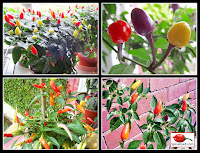Ornamental Chilli Peppers
With dazzling colours such as red, orange, yellow, purple, green, black and white, ornamental chillies come in all the colours of the rainbow and will brighten up any windowsill, conservatory, patio, flowerbed or ornamental border. From varieties like black pearl with its variegated purple, green and black coloured foliage to attractive ornamental dwarf varieties like Prairie Fire, there really is something for everyone.
Ornamental chilli plants are often grown in flowerbeds and ornamental borders in sunny parts of the world to add extra colour and pizzazz to the garden. In temperate climates they're typically grown in decorative pots in conservatories or on windowsills or patios. With a large array of varieties available, such as Black Pearl, Bolivian Rainbow, Peruvian Purple, NuMex Twilight, Prairie Fire, Little Elf, Filius Blue, Pretty Purple, Riot, Orange Blossom, Patagonia, Poinsettia, Medusa and Basket of Fire, adding a splash of colour to your home or garden during the summer is never difficult.
Ornamental chilli plants are developed and grown for aesthetic purposes rather than for culinary usage, but that doesn't mean that the chillies still can be used in cooking. All chilli peppers are edible, including ornamental varieties, but people who grow ornamental varieties for culinary usage often end up being disappointed. If you're looking to grow chilli plants for culinary usage then you're better choosing varieties which have been developed for that very purpose. However, when used sparingly ornamental chillies can be good for spicing up soups and stews and for adding extra fire to sauces, salsas, curries and chili con carne. Contrary to what some people believe, ornamental chillies are not toxic either. This was just a myth that ended up circulating on the internet.
In my opinion, there's no such thing as a bad tasting chilli, unless, of course, you're one of those people who doesn't like the flavour of chillies belonging to either the Capsicum chinense or Capsicum baccatum species. Occasionally, you'll come across some chilli varieties which are hot but don't have much flavour, and most of the ornamental varieties I've ever grown and tried have fallen into this category. Although they're not exactly culinary delights, ornamental chillies are still perfectly edible and can be used for spicing up food. They are typically very spicy and have a very sharp heat, but they don't offer much in the way of flavour. They normally contain lots of seeds too, so are best de-seeded beforehand, especially if you're planning to use several of them in one dish. Alternatively, you can also dry them and make your own chilli flakes or powder, which you can then mix small amounts of into other chilli flakes or chilli powders to give them extra heat.
Ornamental chilli plants are often grown in flowerbeds and ornamental borders in sunny parts of the world to add extra colour and pizzazz to the garden. In temperate climates they're typically grown in decorative pots in conservatories or on windowsills or patios. With a large array of varieties available, such as Black Pearl, Bolivian Rainbow, Peruvian Purple, NuMex Twilight, Prairie Fire, Little Elf, Filius Blue, Pretty Purple, Riot, Orange Blossom, Patagonia, Poinsettia, Medusa and Basket of Fire, adding a splash of colour to your home or garden during the summer is never difficult.
Are Ornamental Chillies Edible?
Ornamental chilli plants are developed and grown for aesthetic purposes rather than for culinary usage, but that doesn't mean that the chillies still can be used in cooking. All chilli peppers are edible, including ornamental varieties, but people who grow ornamental varieties for culinary usage often end up being disappointed. If you're looking to grow chilli plants for culinary usage then you're better choosing varieties which have been developed for that very purpose. However, when used sparingly ornamental chillies can be good for spicing up soups and stews and for adding extra fire to sauces, salsas, curries and chili con carne. Contrary to what some people believe, ornamental chillies are not toxic either. This was just a myth that ended up circulating on the internet.
In my opinion, there's no such thing as a bad tasting chilli, unless, of course, you're one of those people who doesn't like the flavour of chillies belonging to either the Capsicum chinense or Capsicum baccatum species. Occasionally, you'll come across some chilli varieties which are hot but don't have much flavour, and most of the ornamental varieties I've ever grown and tried have fallen into this category. Although they're not exactly culinary delights, ornamental chillies are still perfectly edible and can be used for spicing up food. They are typically very spicy and have a very sharp heat, but they don't offer much in the way of flavour. They normally contain lots of seeds too, so are best de-seeded beforehand, especially if you're planning to use several of them in one dish. Alternatively, you can also dry them and make your own chilli flakes or powder, which you can then mix small amounts of into other chilli flakes or chilli powders to give them extra heat.

